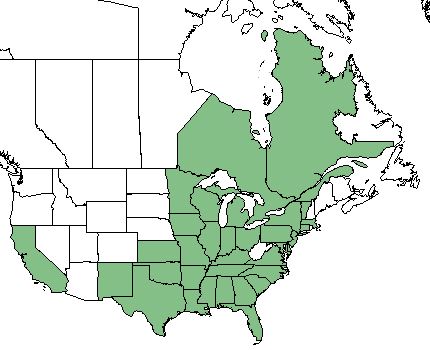Difference between revisions of "Monarda punctata"
| Line 17: | Line 17: | ||
| range_map_caption = Natural range of ''Monarda punctata'' from USDA NRCS [https://plants.usda.gov/core/profile?symbol=MOPU# Plants Database]. | | range_map_caption = Natural range of ''Monarda punctata'' from USDA NRCS [https://plants.usda.gov/core/profile?symbol=MOPU# Plants Database]. | ||
}} | }} | ||
| − | Common Names: Arkansas horse mint; eastern horse-mint; hairy-stem horse mint<ref name="Weakley 2015">Weakley AS (2015) Flora of the Southern and Mid-Atlantic States. Chapel Hill, NC: University of North Carolina Herbarium.</ref> | + | Common Names: Arkansas horse mint; eastern horse-mint; hairy-stem horse mint;<ref name="Weakley 2015">Weakley AS (2015) Flora of the Southern and Mid-Atlantic States. Chapel Hill, NC: University of North Carolina Herbarium.</ref> spotted beebalm<ref name="USDA">USDA NRCS (2016) The PLANTS Database (http://plants.usda.gov, 29 January 2018). National Plant Data Team, Greensboro, NC 27401-4901 USA.</ref> |
==Taxonomic Notes== | ==Taxonomic Notes== | ||
Revision as of 15:50, 29 January 2018
| Monarda punctata | |
|---|---|

| |
| Photo by John B | |
| Scientific classification | |
| Kingdom: | Plantae |
| Division: | Magnoliophyta - Flowering plants |
| Class: | Magnoliopsida - Dicots |
| Order: | Lamiales |
| Family: | Lamiaceae |
| Genus: | Monarda |
| Species: | M. punctata |
| Binomial name | |
| Monarda punctata L. | |

| |
| Natural range of Monarda punctata from USDA NRCS Plants Database. | |
Common Names: Arkansas horse mint; eastern horse-mint; hairy-stem horse mint;[1] spotted beebalm[2]
Contents
Taxonomic Notes
Varieties: M. punctata var. arkansana; M. punctata var. punctata; M. punctata var. villicaulis[1]
Description
Distribution
Ecology
Habitat
M. punctata occurs in dryish forests over mafic rock, maritime forests, dunes, roadsides, rocky or sandy woodlands, and disturbed areas.[1]
Phenology
In the southeastern and mid-Atlantic United States, flowering occurs from July through October.[1]